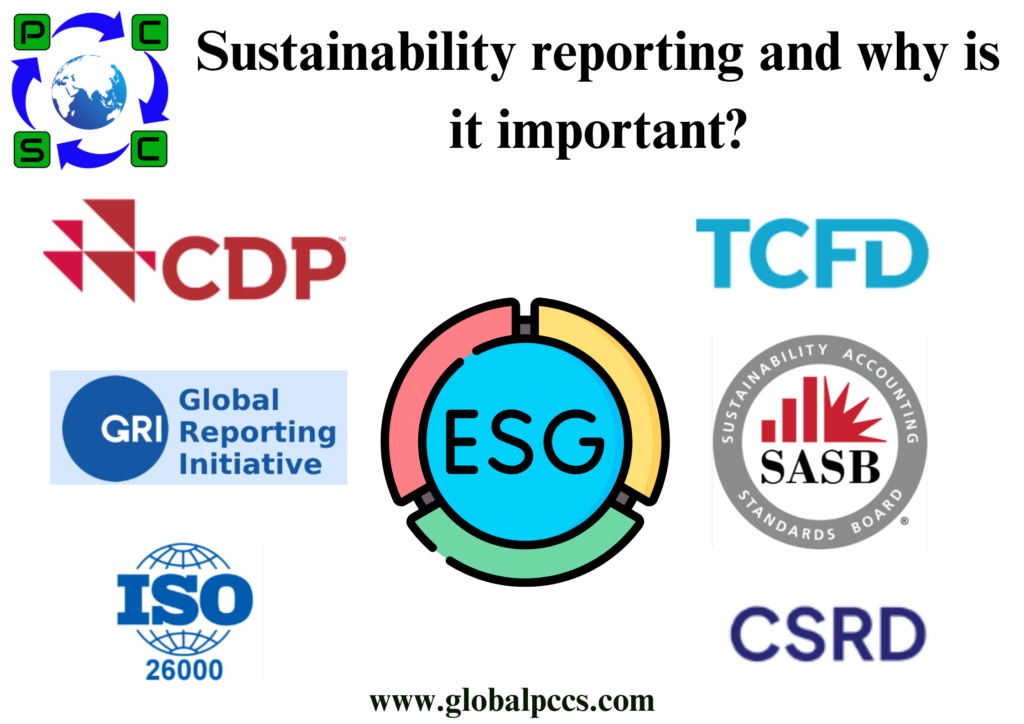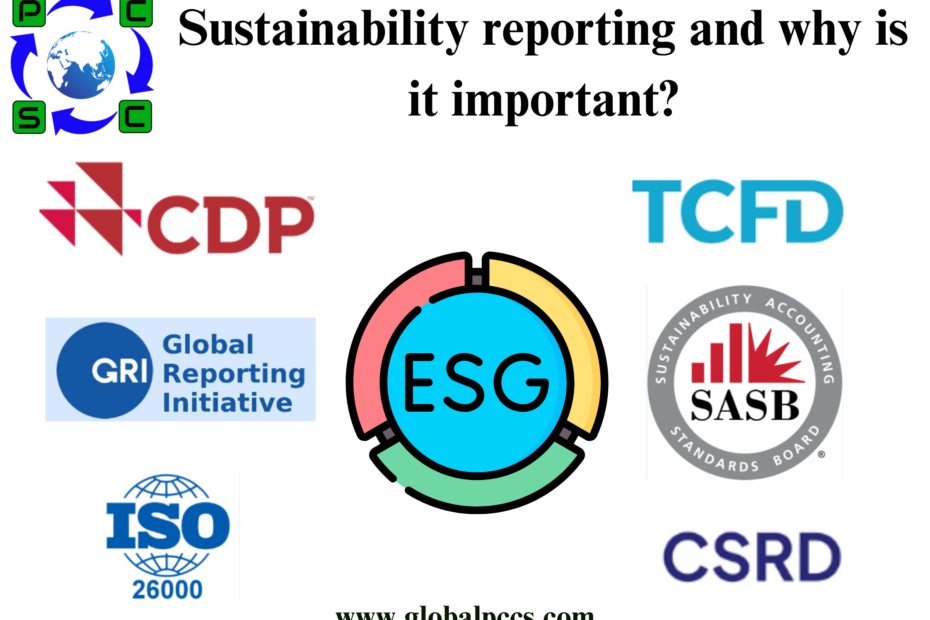 In essence, sustainability reporting entails the disclosure of environmental, social, and governance (ESG) goals, along with communicating the progress made toward achieving these objectives. It goes beyond merely stating the company’s sustainability aspirations by actively assessing the action plan implemented to reach its targets.
In essence, sustainability reporting entails the disclosure of environmental, social, and governance (ESG) goals, along with communicating the progress made toward achieving these objectives. It goes beyond merely stating the company’s sustainability aspirations by actively assessing the action plan implemented to reach its targets.
What are ESG goals?
Environmental, Social, and Governance (ESG) goals are strategic objectives that businesses set to effectively manage their impact on society and the environment. These goals encompass three key categories:
- Environmental – This category focuses on a company’s ecological performance and its efforts to minimise its environmental impact.
- Social – The social aspect encompasses relationship management with employees, suppliers, customers, and communities affected by the company’s operations.
- Governance – Governance goals revolve around analysing the company’s leadership, internal controls, audits, and overall corporate governance practices.
Importantly, there isn’t a single prescribed method for conducting sustainability reporting; multiple frameworks exist to cater to different organisational needs.
Contrary to the perceived rigidity associated with reporting, sustainability reporting offers flexibility in its implementation. However, companies should look to ensure that their report:
- Extends its reach to stakeholders beyond those directly targeted by the integrated report, including financial capital providers
- Provides details about the company’s competitive positioning in the evolving sustainability landscape
- Offers a comprehensive overview of the company’s initiatives relating to social, human, and environmental capital
By addressing these elements in the sustainability report, companies can effectively communicate their commitment to ESG goals, engage stakeholders, and demonstrate their commitment to creating positive social and environmental impacts.
Sustainability reporting frameworks
When it comes to sustainability reporting, there are various approaches that companies can consider. These include:
- Established sustainability reporting frameworks – Companies can utilise widely recognised sustainability reporting frameworks such as the Global Reporting Initiative (GRI) or the Carbon Disclosure Project (CDP). These frameworks provide structured guidelines to assess and disclose environmental, social, and governance (ESG) information.
More on these frameworks later.
- Integrating sustainability into overall performance disclosures – Another option is to incorporate sustainability into the company’s overall performance disclosures. This involves aligning sustainability metrics and goals with financial reporting and other key performance indicators to provide a comprehensive view of the company’s performance.
- International Integrated Reporting Committee (IIRC) Guidelines – The IIRC has developed guidelines for integrated reporting, emphasising the importance of linking financial and non-financial information. Organisations can adopt these guidelines to present a more integrated and balanced view of their performance, including sustainability aspects.
- The Dow Jones Sustainability Index (DJSI) – The DJSI is a prominent benchmark that assesses the sustainability performance of companies across various industries. By meeting the criteria set by the DJSI, companies can enhance their credibility and reputation in terms of sustainability.

By selecting the appropriate reporting framework or guideline, companies can effectively communicate their sustainability efforts, showcase progress, and demonstrate their commitment to responsible business practices.
Why is sustainability reporting important for a company?
Sustainability reporting creates numerous advantages, including the enhancement of risk management strategies, the optimisation of costs and savings, the streamlining of decision-making processes, and the bolstering of corporate trustworthiness and reputation. These effects resonate with both customers and investors alike.
Given that social and environmental risks and opportunities have a strong potential to impact the long-term security and success of a company, it’s essential that companies dedicate both time and resources towards sustainable solutions.
Sustainability reporting serves as a strategic cornerstone, enabling organisations to effectively confront and counter these emerging challenges. Viewed through this lens, sustainability reporting transitions from being a simple corporate responsibility tool to a key element in solidifying a company’s strategic resilience over the long term.
Sustainability reporting provides an insightful narrative of a company’s impact across economic, environmental, and social aspects. Armed with this information, companies will find themselves better equipped to measure, understand, and assess their operational footprint. This understanding supports the formulation of innovative goals and helps companies to implement changes, positioning them more favourably for seamless integration into an increasingly sustainability-centered global economy.
Sustainability reporting advantages
Enhanced risk management
Sustainability is intrinsically linked to resilience. And in today’s world, where climate change deeply impacts business, fostering resilience is key. This calls for a comprehensive review of risk management strategies: understanding potential risks and developing preventive measures to safeguard business interests.
Herein lies the value of sustainability reporting. It’s not just a tool for present risk management; it’s a guide to shape a company’s future operational context, foresee changes, and effectively plan for them.
Optimised costs and savings
Sustainability reporting is also a catalyst for transforming your business model and enhancing operational efficiencies. By prioritising sustainability, companies can shine a light on existing inefficiencies, paving the way for impactful optimisations.

Today’s companies are harnessing sustainability to drive value by trimming operational expenses, refining their value chains, innovating sustainable products or services, reducing their carbon footprint, and promoting efficient natural resource management. Not to mention, sustainability efforts can also enhance social aspects such as employee retention and motivation, fostering a more productive work environment and reducing expenditures linked to employee turnover.
Supports decision-making
Leadership roles inherently involve navigating complex decisions, especially in the face of an uncertain and unpredictable future. This is why sustainability reporting serves as an indispensable tool in the decision-making arsenal.
While a sustainability report may not foresee the future, it does provide invaluable insights into potential environmental and societal shifts. Engaging in sustainability reporting helps preempt the hurdles that global warming and other such issues may present, helping a company to be more resilient.
Consider the context of evolving legal frameworks. Legislation is becoming increasingly stringent towards companies that overlook sustainable development. Given the significant societal challenges we currently face, it’s reasonable to expect a continued tightening of these regulations and penalties. Companies that conduct effective sustainability reporting will be much better prepared to deal with these increasing regulatory hurdles.

Increased stakeholder engagement
Society has undergone significant shifts recently, including a growing demand for transparency from brands and businesses. This isn’t just a passing trend – it’s a necessity for those wishing to retain their customers and employees.
Consumers and potential business partners are more discerning than ever, placing great importance on the alignment of their values with the commitments of the brands they support. It’s become clear that businesses need to take a stand on ethical, environmental, and social issues.
That’s where sustainability reporting comes in. It provides a tangible way to meet this call for transparency. It’s no longer sufficient to merely claim sustainability or reliability – companies need to demonstrate it. Their customers, employees, and stakeholders want assurance that the companies they support are not just trustworthy in words, but also in terms of their actions.
What are the most common sustainability reporting frameworks?
GRI
The Global Reporting Initiative (GRI) Standards, renowned for their comprehensive approach, provide direction on economic, environmental, and social aspects, appealing to a wide array of stakeholders, including investors. This framework, followed by thousands of organisations globally and forming the standard for the United Nations Global Compact, is often regarded as the most well-known and extensively used.
Key Features:
- Comprehensive coverage of a broad range of sustainability issues, including human rights, climate change, and governance.
- Emphasis on stakeholder engagement and transparency.
- Regular updates to reflect the latest sustainability challenges and opportunities.

IIRC
The International Integrated Reporting Council’s Integrated Reporting Framework (IRF) encourages companies to publish ‘concise’ integrated reports. These reports combine traditional annual financial information with ESG (Environmental, Social, and Governance) data, detailing value creation over short, medium, and long-term timeframes.
Key Features:
- Integration of ESG information with financial data.
- A concise representation of a company’s strategy, governance, performance, and prospects.
- Focus on long-term value creation and sustainable business practices.

Sustainability Accounting Standards Board (SASB)
The US-based Sustainability Accounting Standards Board (SASB) provides a unique perspective with its standards, emphasising an introspective look at how sustainability concerns impact a company’s financial performance. One of SASB’s defining features is the creation of over 70 industry-specific standards.
Key Features:
- Industry-specific standards tailored to identify material sustainability issues.
- Focus on the financial impacts of sustainability concerns.
- Useful for benchmarking and providing a standardised reporting framework.

TCFD
The Task Force on Climate-related Financial Disclosures (TCFD) provides recommendations for disclosing clear, comparable, and consistent information about the risks and opportunities presented by climate change. The TCFD framework is widely endorsed by organisations and regulators globally.
Key Features:
- Focus on the financial implications of climate-related risks and opportunities.
- Encourages companies to disclose governance, strategy, risk management, and metrics and targets related to climate change.
- Aligns with investor and regulatory demands for climate-related financial information.

CDP: Carbon Disclosure Project
The Carbon Disclosure Project (CDP) is a global disclosure system that enables companies, cities, states, and regions to measure and manage their environmental impacts. CDP focuses primarily on climate change, water security, and deforestation.
Key Features:
- Encourages the disclosure of greenhouse gas emissions and climate-related risks.
- Provides a scoring system to evaluate companies’ progress in environmental stewardship.
- Aligns with the recommendations of the Task Force on Climate-related Financial Disclosures (TCFD).

Global Compact Self-Assessment Tool
The United Nations Global Compact provides a self-assessment tool for companies to evaluate their sustainability performance against the Ten Principles of the UN Global Compact in areas of human rights, labor, environment, and anti-corruption.
Key Features:
- Aligns with the Sustainable Development Goals (SDGs).
- Provides a structured approach to assess and improve sustainability practices.
- Enhances transparency and accountability.

Carbon Trust Standard
The Carbon Trust Standard certifies organisations that measure, manage, and reduce their carbon emissions and improve their resource management.
Key Features:
- Focuses on carbon, water, and waste management.
- Provides independent verification of sustainability achievements.
- Encourages continuous improvement in environmental performance.

ISO 26000
ISO 26000 is an international standard providing guidelines for social responsibility. While not a certification, it offers guidance on how businesses and organisations can operate in a socially responsible way.
Key Features:
- Provides guidance on concepts, terms, and definitions related to social responsibility.
- Helps organisations integrate social responsibility into their values and practices.
- Covers a wide range of social responsibility topics including human rights, labor practices, the environment, and fair operating practices.

EU Corporate Sustainability Reporting Directive (CSRD)
The EU’s Corporate Sustainability Reporting Directive (CSRD) aims to standardise and enhance the quality of sustainability information disclosed by companies within the EU. This directive replaces the Non-Financial Reporting Directive (NFRD) and significantly expands the scope of reporting requirements.
Key Features:
- Mandatory sustainability reporting for large companies and listed SMEs.
- Requirements to report on environmental, social, and governance issues.
- Alignment with European Green Deal objectives and the Sustainable Finance Disclosure Regulation (SFDR).
- Ensures audited and comparable sustainability information across the EU.









 Authorised IMDS & CDX Training & Consulting partner for
Authorised IMDS & CDX Training & Consulting partner for






